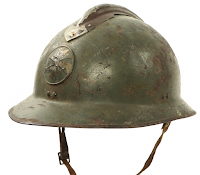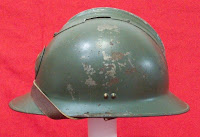
Running around the trenches of the Western Front was very bad for your health. If a bullet didn't catch your scalp, shrapnel might rip it open, or you might succumb to poisonous gas, sent courtesy of the Germans across the way of no-man's-land. When World War I started in August of 1914, the armies of Europe pranced out to battle in a mixed bag of colorful and virtually useless uniforms. The French wore red trousers and dark blue coats, topped off with a red and blue hat. This uniform had remained virtually unchanged for over 80 years. At least the British, Germans, Austrians, and Russians had uniforms to match the earthen colors of Nature's surroundings, but neither side had any sort of meaningful head protection.

In 1915 the French tried. A small stamped steel skull-cap was issued to the troops, la Cervelière, essentially a bowl that would fit under the soft-cap, or képi...and a response to French soldiers already seeing their mess kits resist being struck by shrapnel. It was a stop-gap measure. Something more was needed to ebb the flow of head wounds in this increasingly violent conflict.

Enter, the Model 1915 "Adrian" Helmet, the first of its kind in modern and the first mass-produced military helmet. The "Casque Adrian" was developed in 1915 and was designed to protect trench-bound French soldiers from exploding artillery shell shrapnel. The French were finding that artillery shells exploding above ground troops was causing an unacceptable level of head wounds. Widespread issue of the helmet commenced in 1915, and was in universal use by the next year. Although it carried his name, General Louis Adrian, in charge of the French Army's supply and distribution, did not himself develop the helmet.

It weighed in at almost two pounds (1 lb, 11 oz), was made of .7 millimeter stamped steel, and manufactured in seven separate pieces excluding the helmet line an chinstrap (a bit of assembly was required, but not in the trenches). It was light, inexpensive, and effective. The helmet was actually cheaper for the Army to purchase than the cloth képi had been. Head wounds rates plummeted, and by the end of 1916, 7 million Adrian helmets were in the field atop the heads of French soldiers. It came together like this...the crown of the helmet was one stamped piece, followed by the front visor and the rear visor, joined or riveted together and then attached to the crown, chin strap bevels were riveted on, and a comb was riveted to the top of the crown. This comb served two purposes, one it was decorative and made the helmet distinct. Secondly, it strengthened the helmet and served as a deflection point for shrapnel coming from above. That's what this helmet was for. It was not meant to stop a bullet. The issue helmet was very good at its job. The metal was thinner so it would break into shards if hit, unlike some private manufactured copy-cat Adrian's sold to unwary officers who just had to spend more and thinking they were better off. These knock-off helmets were made from harder and thicker metal, which would shatter or splinter inward, ripping apart scalp, skull, and brain...and then there was the paint...
Horizon Blue...this was the color chosen by the French armed forces to replace the red trousers and dark blue coats that had garbed their soldiers since the middle of the 19th century. By 1916, most French troops were wearing this new colored uniform. Interestingly, they also used a mustard or brown colored uniform, but only for colonial soldiers, those that came from French colonies in Africa, the Middle East, East Asia (Vietnam) and the Foreign Legion. A brown colored uniform would blend in much better with the mud of the trenches and the shell pocked landscape of "No Man's Land", but blue was what the French in all their infinite wisdom chose for a majority of their troops fighting in this, the Great War. Maybe they surmised that it would blend their soldiers into the blue sky as they flung soldiers into the meat grinder of German machine guns.
The Mle.1915 helmet was painted to match. Blue or mustard brown/khaki. Early production helmets had a nice gloss finish. It made it extremely convenient for a German sniper, as the sun reflected off the new French helmet and provided a target that could be seen from a long distance. French soldiers figured this out very quickly, and even before the high command ordered cloth helmet covers to be fashioned, troops were making them from whatever material they could get their hands on...sandbag cloth, or burlap, being the most readily available. In some cases, French soldiers would repaint the helmet in the field if they had the supplies, or smear dirt and mud on the helmet to dull its profile. Eventually, the government manufactured and issued cloth helmet covers, but there was another problem. When a head wound occurred, dirty and nasty bits of the cover would be blown right into the wound, causing infection, which could invariably lead to the soldier's death. Reversing themselves because of this, the French ordered their troops not to wear helmet covers. Some soldiers nevertheless continued to do so. But what about the glossy paint? It was discovered in the factory painting process, when the helmet was baked longer (paint was applied then placed in an oven) it would come out with with a flat finish, most of the gloss being removed. From June of 1916, this method was employed and it seemed to have solved this problem. By July, these helmets, with the flat finish, started to be issued to soldiers at the Front.
Unique to the Adrian helmet was the badge placed on the front to denote branch of service. Two holes were punched in the front of the helmet's crown and a pressed metal badge with a metal prong on the back was slotted in. These badges in in and of themselves were laborious to make and required multiple set-ups and tooling. Each was different, adding an extra layer of unnecessary manufacture...differing from British of German helmet production which carried no such factory made insignia. Recent stress testing by Duke University concluded that the slots for the insignia in the front of the helmet weakened it structure and made it less successful...perhaps that is why some countries who ordered Adrian helmets for their army, bypassed this extra added feature, or they just figured its was simply frivolous...I would surmise it was the later, with an unrecognized benefit.
The Mle.1915 helmet served the French, and other nations, well into the mid 20th-century. Examples were even pressed into service by Nazi Germany, being captured after the fall of France in 1940 and issued as Air Raid Warden/Luftshutz helmets.

1926 saw a new revision of the Adrian, simplifying the manufacturing and redesigning the manufacture. The Mle.1926 helmet kept the same shape, but was no longer in 4-pieces. The helmet shell was now pressed as one-piece, with the comb remaining as separate. 1926 also saw the end of Horizon Blue, both for helmets and uniforms, the whole of the army switching to olive drab, or greenish brown...like most of the World's ground forces.

The French were very progressive in their equipment and designs during the Great War. Their helmets (and their tanks) were purchased by a number of foreign allied nations. Financially, the French made a lot of money by doing this...It cost a little over 3 francs to manufacture and Adrian helmet, and France sold it for 6...including a custom insignia, if you so desired...
Here is a list of all the countries who purchased and/or used the French Mle.1915 and or Mle.1926 helmets:
Belgium
Poland
Russia...both Tsarist and Soviet
United States
Albania
Luxembourg
Latvia
China
Japan
Brazil
Greece
Italy
Siam (Thailand)
Spain
Czechoslovakia
Yugoslavia
Serbia
Romania
Peru
Mexico
Turkey
Morocco









